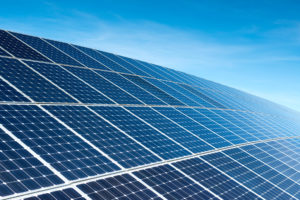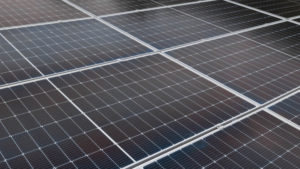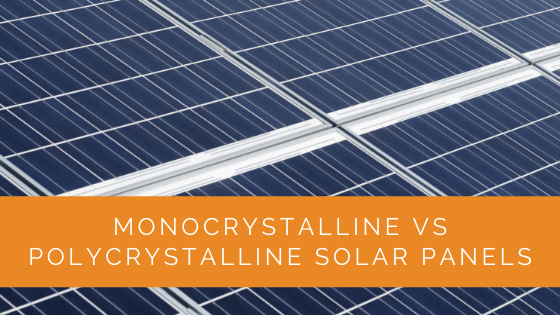Should you go with monocrystalline or polycrystalline solar panels? That’s probably the first question that comes to mind when you begin your research. And it’s a valid question! After all, both types of solar panels have unique advantages and disadvantages, making it challenging to pick one.
Ultimately, though, one may be a better fit for your home or business, and we want to ensure you make the best decision possible. Therefore, we’ll review everything you need to know about these two types of solar panels. Let’s get into it, shall we?
Contents
- 1 Key Takeaways
- 2 What Are Monocrystalline Solar Panels?
- 3 What Are Polycrystalline Solar Panels?
- 4 Monocrystalline vs Polycrystalline Solar Panels: The Full Comparison
- 5 Monocrystalline or Polycrystalline Solar Panels: What’s Right for You?
- 6 Case Study: Choosing the Right Type of Solar Panel for a Residential Project
- 7 Expert Insights From Our Solar Panel Installers About Choosing Between Monocrystalline and Polycrystalline Solar Panels
- 8 Discover the Power of Solar with Solar Panels Network
- 9 Final Verdict
Key Takeaways
- Monocrystalline solar panels are made from a single piece of silicon crystal and are more efficient and durable but come at a higher cost than polycrystalline panels.
- Polycrystalline solar panels have multiple silicon crystals and are less expensive, more versatile in installation, and suitable for cold climates.
- The choice between monocrystalline and polycrystalline panels depends on budget, appearance preferences, efficiency, longevity, inverter efficiency, maintenance, roof strength, and climate conditions.
What Are Monocrystalline Solar Panels?
Monocrystalline panels are made from a single piece of silicon crystal. This can be sliced from a wafer or cast into shape by melting and cooling solid polysilicon.
Each black monocrystalline solar cell is created from this single piece of crystallised silicon, which means they’re all electrically linked. That means they have the same voltage and operate at the same current.
So, to identify monocrystalline solar panels, look for cells with “mono” or “M cycles”. They’re also often referred to as single-crystalline panels or mono-solar panels.
What Are Polycrystalline Solar Panels?
Polycrystalline solar panels are made using similar techniques as monocrystalline, but their blue cells have multiple silicon crystals, although they aren’t all electrically connected.
When melted, natural silicon has a square-shaped crystal structure. In polycrystalline solar panels, the silicon is melted without changing its square shape. That means that when it cools down, it won’t have a perfect crystal structure and will have small crystals with boundaries between them.
Since they only have a portion of each crystal’s electrical connections, they’re connected in series. Therefore, polycrystalline solar cells have a higher voltage than monocrystalline ones, so they must be added in groups of several dozen cells.
So, you’ll often see “poly” or “P cycles” when looking for polycrystalline solar panels. They’re also known as multi-crystalline panels or “poly panels”.
Monocrystalline vs Polycrystalline Solar Panels: The Full Comparison
Now that you understand what monocrystalline and polycrystalline panels are let’s look at how they compare against each other so you can choose which type of solar panels suits your needs.
Appearance
The most noticeable difference between monocrystalline and polycrystalline solar panels is their hue.
Polycrystalline solar panels are blue because of their crystal structure. Because they’re made up of one piece of silicon, Monocrystalline panels are black or dark grey. This can also be seen in their appearance at the edges surrounding each cell.
You can tell them apart by looking at them, which is great news for consumers. It means you can easily see which type of panel you’re dealing with without referring to the label or any specifications. This is especially so if you’re trying to match your rooftop with aesthetically pleasing panels.

Cost
Monocrystalline solar panels tend to be more expensive than polycrystalline ones. It takes much longer to create monocrystalline cells than polycrystalline cells, so the silicon structure causes this price gap.
Because of the complex process of producing monocrystalline solar panels, only a handful of manufacturers can produce them. This makes it an expensive commodity, so they’re often more expensive than polycrystalline panels.
Efficiency
Regarding efficiency, both types of solar panels are pretty efficient and have an efficiency rate between 13-16%.
However, monocrystalline panels have an advantage over polycrystalline solar panels and are more efficient. This means that the amount of electricity they create is greater for a comparable area of solar panels.
As a result, this also makes monocrystalline panels more attractive for rooftop residential setups since they need less space to produce an equivalent amount of energy. So, while polycrystalline solar panels may be a better option in terms of price, you’ll get a much better ROI from investing in monocrystalline panels.
Durability
Monocrystalline solar panels are known for being more durable than polycrystalline ones because they’re made up of one piece of pure silicon crystal instead of multiple pieces that are held together with a binding agent. So, what are the numbers?
Monocrystalline panels generally have a lifespan of around 25-40 years, while polycrystalline solar panels have an average lifespan of approximately 20-35 years.
However, the expectations for each type of panel to last this long can vary depending on usage and conditions. For example, if you’re in a region frequently hit with harsh weather conditions, they might not last as long as someone who lives in an area without snow.
Temperature Coefficient
The temperature coefficient is another specification affecting your solar panels’ performance. It’s a number assigned to describe how the current output changes against varying temperatures.
As you might expect, monocrystalline solar panels retain more heat than polycrystalline ones because they’re made up of one solid piece instead of multiple fragments. So, they have a lower temperature coefficient and can lose more efficiency in colder weather. They’re more efficient in heat.
In comparison, polycrystalline solar panels have a higher temperature coefficient, which means they’re relatively inefficient at converting heat into energy and will continue to lose efficiency as it gets hotter.
Because of this, monocrystalline panels are the better option for homeowners who plan on using their solar panels during those hot summer days.
Installation Style
Monocrystalline and polycrystalline panels are installed in very different ways for rooftop setups. The main difference is that monocrystalline panels are cut into squares and then assembled to form a larger panel, which means they’re perfect if you need to cover an area with multiple panels.
On the other hand, polycrystalline solar panels are made using a casted moulding process and consist of multiple fragments that interlock next to each other to form a larger panel.
As a result, they have a more flexible installation method and are easier to install across large areas or around complex shapes on your rooftop. This includes slanted roofs and off-grid installations on flat ground where you don’t need to worry about space.
Monocrystalline or Polycrystalline Solar Panels: What’s Right for You?
So, which type of solar panels is better? As you can see, both types of solar panels have advantages and disadvantages depending on how they’re used. Here are the factors you should consider when making a decision.
Budget
Monocrystalline solar panels will be more expensive than polycrystalline ones because they’re made with a higher grade of pure silicon crystals. However, you’ll need fewer panels for equivalent energy, and the efficiency will make up for it in the long run.
So, if you don’t mind spending a little more upfront for better performance in the long run, then monocrystalline panels could be the best option. But if you’re on a budget and want to get the most out of your money, then polycrystalline panels could be the right choice.

Versatility
Polycrystalline panels are a better option if you use your solar panels for rooftop setups, whether on an RV, boat or in a remote cabin. They have a more flexible installation method and can handle complex shapes easily.
Appearance
If you’re concerned about aesthetics and colour, remember that monocrystalline panels are more uniform than polycrystalline ones. Monocrystalline panels are darker (nearly black), while polycrystalline ones have a bluer tone. Based on that, most homeowners prefer monocrystalline solar panels since they seamlessly blend in with the roof.
However, this isn’t a huge consideration because both panels look very similar from a distance when installed. Solar panel manufacturers are increasingly offering monocrystalline panels in different colours to match your house or business.
Efficiency and Longevity
Monocrystalline solar panels have a higher efficiency rate, are more durable, and retain more heat. This means they’re better if you use your solar panels all year round and live in hot, sunny climates.
If you use your solar panels during the winter or don’t plan on utilising them all year round, then polycrystalline solar panels will work fine.
Other Factors to Consider
Price, versatility, and efficiency are certainly important for solar panel selection. However, it would be best to consider a few other things before making your final decision.
- Inverter Efficiency: If you have an off-grid solar system, the inverter’s efficiency will also need to be considered since it can affect your overall energy production. With this in mind, you’ll want to ensure the inverter is optimised for whichever type of solar panel you decide.
- Maintenance: Both panels have a similar availability and replacement rate if they break or malfunction. Both types are generally easy to maintain, and most manufacturers offer warranties that include parts and labour.
- Roof Strength: Monocrystalline solar panels are more robust than polycrystalline ones, which can handle heavier snow, ice, and wind. This makes monocrystalline solar panels the better choice if you live in an area with extreme weather conditions.
- Weight-to-Power Ratio – Monocrystalline solar panels have a higher weight-to-power ratio, which means they’re more cost-effective since you’ll need fewer modules.
Case Study: Choosing the Right Type of Solar Panel for a Residential Project
Background
Solar Panels Network was approached by a family in southern England who were interested in transitioning their home to solar power. They were particularly concerned with finding the most efficient and cost-effective solar panel system to meet their energy needs while also considering the visual impact on their property.
Project Overview
The family’s primary goals included reducing their electricity bills and minimising their carbon footprint. They also wanted a solar panel system that would blend aesthetically with their home. Our team was tasked with advising on whether to choose monocrystalline or polycrystalline solar panels, considering their specific needs and circumstances.
Implementation
- Initial Assessment and Energy Analysis: The first step involved assessing the family’s average annual electricity usage, which was approximately 8,500 kWh. Given their energy consumption and the available roof space, we calculated that a 7 kW solar system would be sufficient to meet their needs.
- Monocrystalline vs Polycrystalline Decision-Making: We presented both options to the family, explaining the pros and cons of each:
- Monocrystalline Panels: We highlighted the higher efficiency (around 20-22%), sleeker appearance, and better performance in low-light conditions. These panels are also known for their durability and long lifespan, making them a robust long-term investment.
- Polycrystalline Panels: These panels offered a more budget-friendly option, with slightly lower efficiency (15-17%) but still providing good performance, particularly in cooler temperatures. We noted their characteristic blue colour and discussed the potential cost savings from choosing this option.
- Customer Considerations: The family was particularly concerned about the aesthetic impact of the panels on their property. They preferred the uniform black appearance of the monocrystalline panels, which they felt would blend better with their home’s roof. Additionally, they valued the higher efficiency, which would allow for fewer panels to meet their energy needs.
- Installation and Configuration: Based on these considerations, the family opted for monocrystalline panels. Our installation team configured the panels to optimise sun exposure, ensuring maximum efficiency throughout the year. The panels were installed at an ideal tilt angle and orientation, maximising energy production.
Results
- Energy Efficiency and Cost Savings: The monocrystalline panels exceeded the family’s energy needs, producing enough electricity to cover nearly all their consumption. The system’s high efficiency also meant that fewer panels were needed, preserving roof space and reducing overall installation costs.
- Aesthetic Integration: The panels’ sleek black design blended seamlessly with the roof, maintaining the property’s visual appeal. The family expressed satisfaction with the appearance and performance of their new solar system.
- Environmental Impact and ROI: The installation significantly reduced the family’s reliance on grid electricity, leading to lower utility bills and a reduced carbon footprint. The high efficiency and longevity of the monocrystalline panels ensured a good return on investment, with payback expected within seven years.
Summary
This case study illustrates the critical considerations when choosing between monocrystalline and polycrystalline solar panels. The family’s preference for aesthetics, efficiency, and long-term savings led them to choose monocrystalline panels, which offered the best fit for their specific needs. At Solar Panels Network, we continue to provide tailored solutions, ensuring our clients make informed decisions that align with their goals and circumstances.
Expert Insights From Our Solar Panel Installers About Choosing Between Monocrystalline and Polycrystalline Solar Panels
Monocrystalline panels are often preferred for their high efficiency and sleek black appearance, making them ideal for residential rooftops where space is limited and aesthetics matter.
Lead Solar Installation Specialist
Polycrystalline panels are a great choice for larger installations with plenty of space, such as commercial properties or rural areas. They’re cost-effective and offer good efficiency, especially in cooler climates.
Senior Solar Engineer
When deciding between monocrystalline and polycrystalline, consider your budget and energy needs. Monocrystalline panels offer higher efficiency and longer lifespan, while polycrystalline panels are more affordable and versatile.
Solar Technology Consultant
Discover the Power of Solar with Solar Panels Network
Are you navigating the world of solar installations? Look no further than Solar Panels Network, the UK’s trusted partner in harnessing the sun’s potential. Our dedication goes beyond just installations; we’re on a mission to transform how homeowners and businesses across the UK perceive and utilise energy. By choosing us, you’re reducing your carbon footprint and making a smart financial move that promises savings for years ahead. Contact us today and embark on your solar journey.
Final Verdict
While monocrystalline and polycrystalline solar panels differ, they use the same underlying technology that converts sunlight into energy. As a result, the performance of both types is similar.
Suppose you live in a warm area, want to maximise energy production with fewer panels, or need your panels to withstand extreme weather conditions. In that case, monocrystalline solar panels are the better choice.
However, polycrystalline solar panels will work fine if you live somewhere cold or want to reduce your initial investment. It ultimately comes down to personal preference and how you plan on using your solar panel system.
Regardless of which type you choose, you can’t go wrong with either one. You’ll start seeing a return on your investment immediately, and both types will provide clean energy for years.
About the Author
Solar Panels Network stands at the forefront of solar energy solutions, driven by a team of seasoned solar engineers and energy consultants. With over decades of experience in delivering high-quality solar installations and maintenance, we are committed to promoting sustainable energy through customer-centric, tailored solutions. Our articles reflect this commitment, crafted collaboratively by experts to provide accurate, up-to-date insights into solar technology, ensuring our readers are well-informed and empowered in their solar energy decisions.

